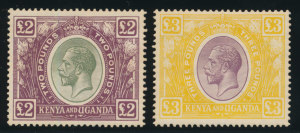When collectors rail about excess new issue stamps soaking up their collecting budget and leaving them with little to spend on older stamps, they are only part of a long tradition of collectors who have bought stamps for their collections that were issued for reasons other than postal need. Some of the most popular stamps in all of philately, the George V and George VI high values, fit this description. When they were first issued, the enormous face values of some of the stamps (even up to as much as 100 Pounds postage value, a sum equal to the average annual wage for a construction worker in 1920-1930, the years such stamps were being issued) cause dolorous denunciations in the philatelic press.
 The high pound value stamps were only issued for a few African and Asian colonies, and there was a shred of legitimacy to them. The countries, which included Kenya, Uganda, and Tanganyika and Ceylon, were places where quantities of valuable smaller items such as diamonds and gold could be posted, and, it was surmised, that stamps might be needed to pay for packages sent from these areas. Really, though, the stamps were doing double duty, so to speak. The stamps were inscribed “Postage and Revenue,” and it is many times more likely to see used stamps that were used to pay fiscal duties than for use as postage stamps. The Scott catalog usually prices these stamps both postally used and with fiscal cancels (fiscal use is usually indicated by a pen or manuscript cancel, or by a colored cancel—usually red). Such revenue use is generally priced at only a few percent of the postally used price, though the ratio of fiscal to postal cancels has been moving in favor of the fiscal in the last twenty years as a new generation of collectors enters the market that hadn’t been aware of how disparaged fiscal cancels had been in the press in the 1930-1950 period. Fiscal cancels too have become less common as, unfortunately, forgers have removed these pen cancels and tried to regum the resulting stamp to sell as mint. The result is rarely very convincing, but the attempt has removed a number of revenue canceled stamps from the market.
The high pound value stamps were only issued for a few African and Asian colonies, and there was a shred of legitimacy to them. The countries, which included Kenya, Uganda, and Tanganyika and Ceylon, were places where quantities of valuable smaller items such as diamonds and gold could be posted, and, it was surmised, that stamps might be needed to pay for packages sent from these areas. Really, though, the stamps were doing double duty, so to speak. The stamps were inscribed “Postage and Revenue,” and it is many times more likely to see used stamps that were used to pay fiscal duties than for use as postage stamps. The Scott catalog usually prices these stamps both postally used and with fiscal cancels (fiscal use is usually indicated by a pen or manuscript cancel, or by a colored cancel—usually red). Such revenue use is generally priced at only a few percent of the postally used price, though the ratio of fiscal to postal cancels has been moving in favor of the fiscal in the last twenty years as a new generation of collectors enters the market that hadn’t been aware of how disparaged fiscal cancels had been in the press in the 1930-1950 period. Fiscal cancels too have become less common as, unfortunately, forgers have removed these pen cancels and tried to regum the resulting stamp to sell as mint. The result is rarely very convincing, but the attempt has removed a number of revenue canceled stamps from the market. The high value British stamps are very scarce and are beautifully printed. Once a new generation of collectors entered the hobby, the stamps became very popular. This is a continuing pattern in philatelic history—stamps that were scorned because they were unnecessary and thought, therefore, to bilk collectors are held in esteem by the next generation who has little awareness of the history. In philately, George Santayana famous dictum that “Those who don’t remember the past are condemned to repeat it,” is transformed into something more like, “The collector with little knowledge of philatelic history gets to collect some very pretty stamps.”
The high value British stamps are very scarce and are beautifully printed. Once a new generation of collectors entered the hobby, the stamps became very popular. This is a continuing pattern in philatelic history—stamps that were scorned because they were unnecessary and thought, therefore, to bilk collectors are held in esteem by the next generation who has little awareness of the history. In philately, George Santayana famous dictum that “Those who don’t remember the past are condemned to repeat it,” is transformed into something more like, “The collector with little knowledge of philatelic history gets to collect some very pretty stamps.”
